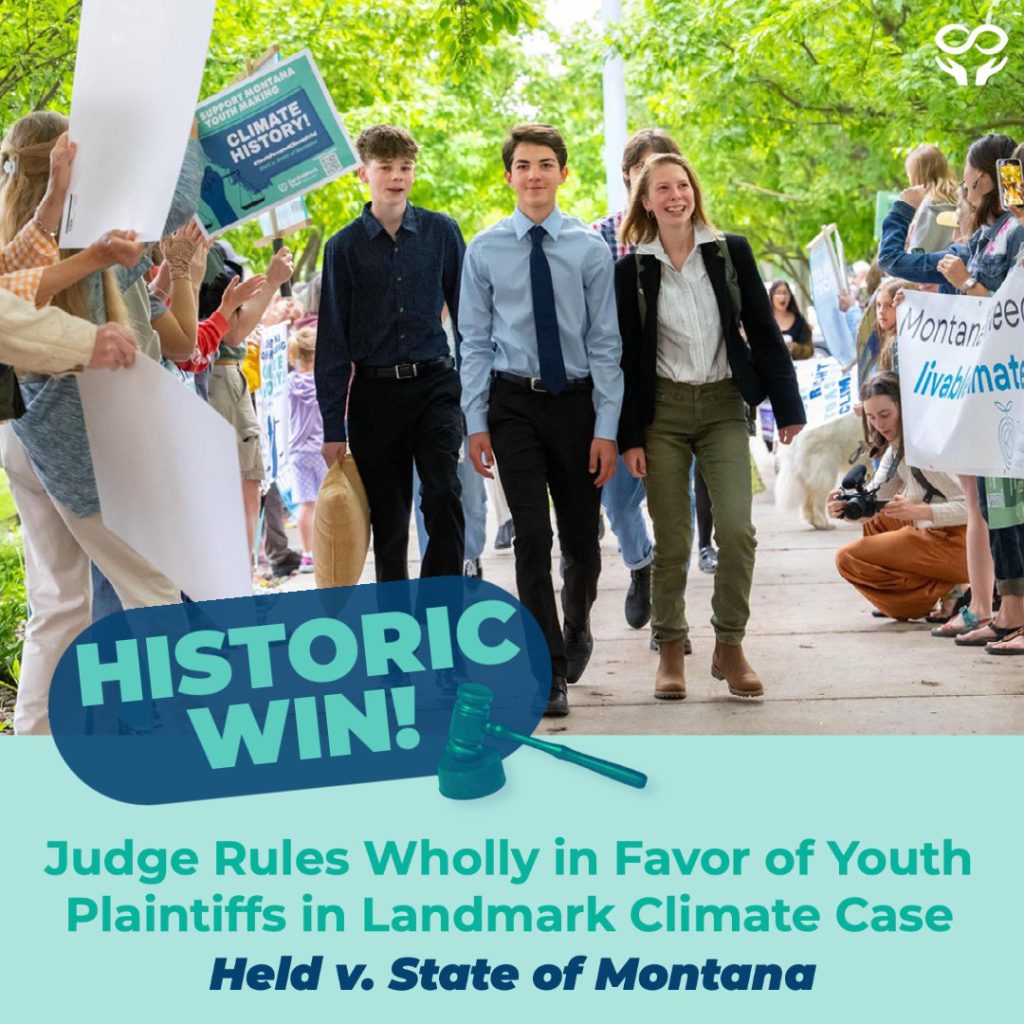
@MichaelGerrard:
… After a trial where climate scientists testified under oath and were subject to cross examination (very rare in itself), the court issued a 103-page decision that found that fossil fuel use is the principal cause of climate change, which in turn is causing serious health and environmental impacts that will continue to get worse.
The court found that renewables (wind, solar, hydro) can economically substitute for fossil fuels; that the youth plaintiffs have a right to a stable climate system under the right to a clean environment in the state constitution; and that the state law barring consideration of climate in impact assessment is unconstitutional.
@GeoffreySupran:
Holy sh!t, America’s first ever constitutional climate trial has just been WON by Montana youth. This is the first US court to find a government guilty of violating citizens’ rights to a healthy environment, joining courts in Germany, Netherlands, Colombia.
***
1902 10 15: Hint to Coal Consumers. Newspaper article in The Selma Morning Times, Selma, Alabama, US, describes theory by Swedish Prof Svante Arrhenius that coal combustion may cause extinction of the human race because of catastrophic global warming – “the earth will be baked in a temperature close to the boiling point.”
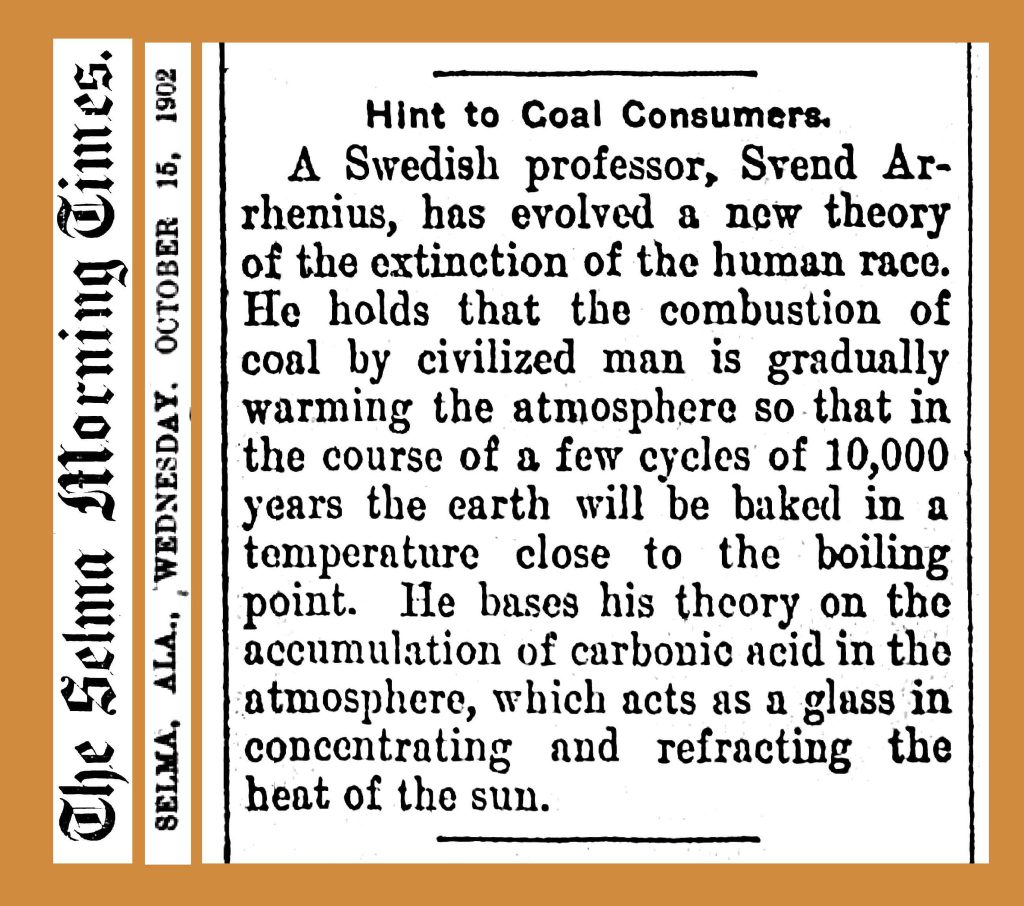
1912 08 14 The Rodney & Otamatea Times. Science Notes and News. Coal Consumption Affecting Climate. Published 111 years ago today.
“The furnaces of the world are now burning about 2,000,000,000 tons of coal a year. When this is burned, uniting with oxygen, it adds about 7,000,000,000 tons of carbon dioxide to the atmosphere yearly. This tends to make the air a more effective blanket for the earth and to raise it’s temperature. The effect may be considerable in a few centuries.”
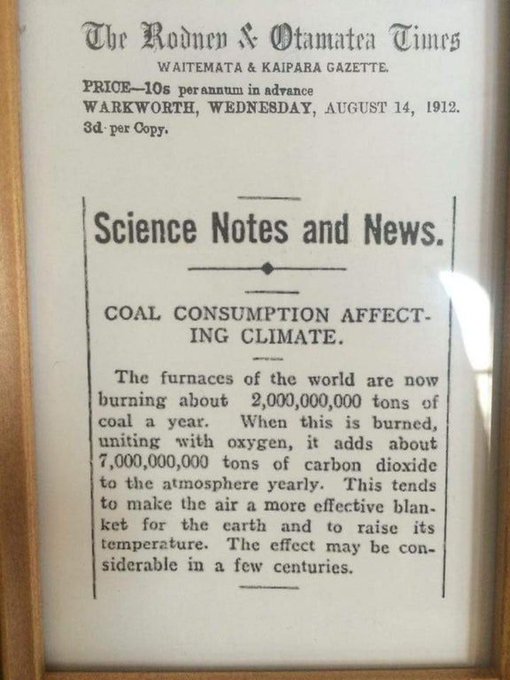
***
Aug 12, 2023 Marl Z. Jacobson:
‘Oxy CEO Vicky Hollhub has said that because of DAC [Direct Air Capture], “we don’t need to ever stop oil'”
“a 2019 study that examined impacts of DAC..found it would increase CO2 , air pollution, fossil mining and fossil infrastructure”![]() Of course it will. It’s intentional, a scam created by polluting corporations to con the masses to keep buying their toxic lies and harms.
Of course it will. It’s intentional, a scam created by polluting corporations to con the masses to keep buying their toxic lies and harms.![]()
August 14 2023: Brian Brettschneider@Climatologist49:
July global temperature compared to the 20th Century average according to NASA Gistemp data released today. Something has changed.
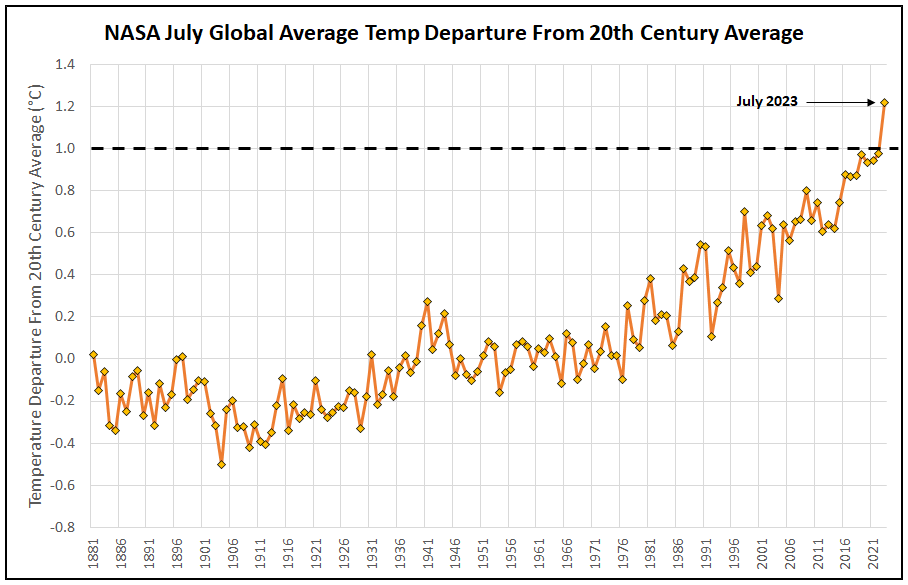
![]() Yes indeed something changed. Massive industrial high pressure horizontal frac’ing by the oil and gas industry invaded the world in earnest around 2010, intentionally venting and leaking incredible amounts of methane (worse green house gas than CO2 in the short term) and other gases, polluting communities 24/7 with clouds of diesel fumes, and permanently removing vast amounts of water from the hydrogeological cycle.
Yes indeed something changed. Massive industrial high pressure horizontal frac’ing by the oil and gas industry invaded the world in earnest around 2010, intentionally venting and leaking incredible amounts of methane (worse green house gas than CO2 in the short term) and other gases, polluting communities 24/7 with clouds of diesel fumes, and permanently removing vast amounts of water from the hydrogeological cycle.
The Leaks that threaten the clean image of natural gas
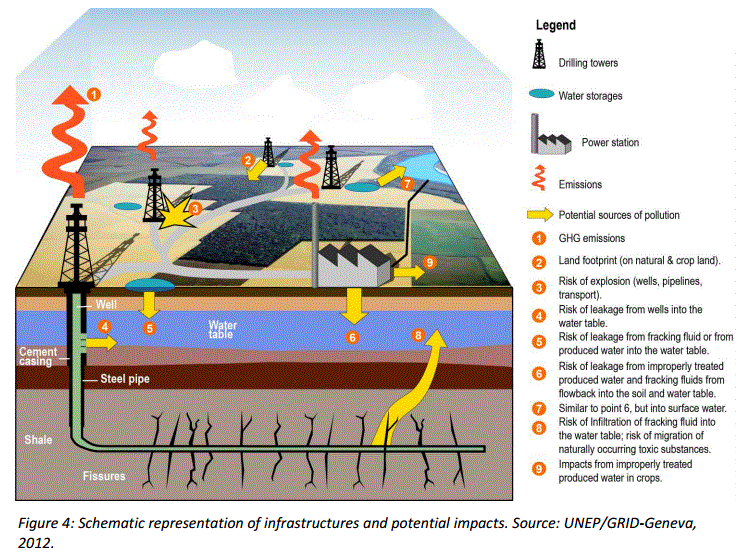
And started/starting how many wildfires?
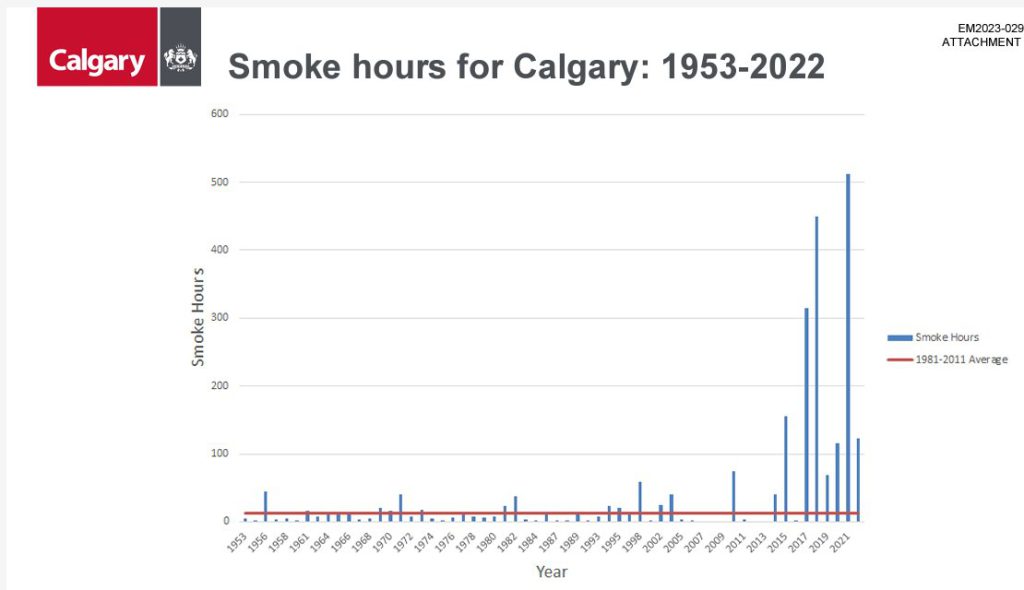
From Page 13, City of Calgary Report![]()
Anthony Kotzebue@AKotzebue:
Damn the first July over 1.0° C above the long term mean
Westhawk @Westhawk12:
Not even dipping anymore, just going up…
Bubs@Jenfeds73:
It’s literally time to act like this is the global emergency it is.
We should be banning private planes and even leisure commercial travel just to start![]() And even more important, humans need to stop making babies – at the very least be legally allowed to choose, notably after rape instead of birthing forced on girls and women by extremely cruel misogynistic religions – until our species figures this emergency out and finds a real solution to it – NOT the fossil fuel industry’s lusted after carbon capture and storage which is a known failure but works well for the rich to suck yet more $billions for themselves out of public coffers. But, toning down over breeding and over consumption will never happen because humans are too selfish, too greedy, too corrupted and too brainwashed to give a damn.
And even more important, humans need to stop making babies – at the very least be legally allowed to choose, notably after rape instead of birthing forced on girls and women by extremely cruel misogynistic religions – until our species figures this emergency out and finds a real solution to it – NOT the fossil fuel industry’s lusted after carbon capture and storage which is a known failure but works well for the rich to suck yet more $billions for themselves out of public coffers. But, toning down over breeding and over consumption will never happen because humans are too selfish, too greedy, too corrupted and too brainwashed to give a damn.![]()
None of that can continue and also have humanity survive
***
‘Game-changer’: judge rules in favor of young activists in US climate trial, Sixteen young plaintiffs had alleged the Montana state government had violated their right to a healthy environment by Supported by Dharna Noor, 14 Aug 2023, The Guardian
The judge who heard the US’s first constitutional climate trial earlier this year has ruled in favor of a group of young plaintiffs who had accused state officials in Montana of violating their right to a healthy environment.
“I’m so speechless right now,” Eva, a plaintiff who was 14 when the suit was filed, said in a statement. “I’m really just excited and elated and thrilled.”
The challengers’ lawyers described the first-of-its-kind ruling as a “game-changer” and a “sweeping win” which campaigners hope will give a boost to similar cases tackling the climate crisis.
In a case that made headlines around the US and internationally, 16 plaintiffs, aged five to 22, had alleged the state government’s pro-fossil fuel policies contributed to climate change.
In trial hearings in June, they testified that that these policies therefore violated provisions in the state constitution that guarantee a “clean and healthful environment,” among other constitutional protections.
On Monday, Judge Kathy Seeley said that by prohibiting government agencies from considering climate impacts when deciding whether or not to permit energy projects, Montana is contributing to the climate crisis and stopping the state from addressing that crisis.
The 103-page order came several weeks after the closely watched trial came to a close on 20 June.![]() Compare to the supreme court of Canada releasing their nothing ruling (there had been no trial yet and no evidence was allowed) a year after hearing Ernst vs AER on a simple matter of law – is Canada’s constitution the highest law in the land? (It is.) And ruling the AER (100% industry funded) can trump the constitution as it pleases, leaving me no way to get remedy for AER violating my rights and adding insult to injury, ordering me to pay AER’s legal costs even though my case was clearly in the public interest.
Compare to the supreme court of Canada releasing their nothing ruling (there had been no trial yet and no evidence was allowed) a year after hearing Ernst vs AER on a simple matter of law – is Canada’s constitution the highest law in the land? (It is.) And ruling the AER (100% industry funded) can trump the constitution as it pleases, leaving me no way to get remedy for AER violating my rights and adding insult to injury, ordering me to pay AER’s legal costs even though my case was clearly in the public interest.![]()
“My initial reaction is, we’re pretty over the moon,” Melissa Hornbein, an attorney at the Western Environmental Law Center who represented the plaintiffs in the 2020 lawsuit said, reacting to the news. “It’s a very good order.”
Julia Olson, who founded Our Children’s Trust, the non-profit law firm that brought the suit alongside Western Environmental Law Center and McGarvey Law, said the case marks the first time in US history that the merits of a case led a court to rule that a government violated young people’s constitutional rights by promoting fossil fuels.
“In a sweeping win for our clients, the Honorable Judge Kathy Seeley declared Montana’s fossil fuel-promoting laws unconstitutional and enjoined their implementation,” she said. “As fires rage in the west, fueled by fossil fuel pollution, today’s ruling in Montana is a game-changer that marks a turning point in this generation’s efforts to save the planet from the devastating effects of human-caused climate chaos.”
The challengers had alleged that they “have been and will continue to be harmed by the dangerous impacts of fossil fuels and the climate crisis.” Similar suits have been filed by young people across the US, but Held v Montana was the first case to reach a trial.
Among the policies the challengers targeted: a provision in the Montana Environmental Policy Act (MEPA) barring the state from considering how its energy economy climate change impacts.
This year, state lawmakers amended the provision to specifically ban the state from considering greenhouse gas emissions in environmental reviews for new energy projects.
That provision is unconstitutional, Seeley ruled.
“By prohibiting consideration of climate change, [greenhouse gas] emissions, and how additional GHG emissions will contribute to climate change or be consistent with the Montana constitution, the MEPA limitation violates plaintiffs’ right to a clean and healthful environment,” Seeley wrote.
The legislature had previously amended the law to prevent environmental reviews from considering “regional, national or global” environmental impacts – a provision the original complaint called the “climate change exception”. When lawmakers changed the provision again in 2023, the state’s attorneys said that should have rendered the lawsuit moot, but Seeley rejected the argument in May.
In her Monday ruling, Seeley also enjoined another 2023 state policy which put stricter parameters around groups’ ability to sue government agencies over permitting decisions under the Montana Environmental Policy Act. That policy “eliminates MEPA litigants’ remedies that prevent irreversible degradation of the environment, and it fails to further a compelling state interest”, rendering it unconstitutional, Seeley wrote.
At the trial in June, attorneys for the state argued that Montana’s contributions to the climate crisis are too small to make any meaningful contribution to the climate crisis. But in her ruling, Seeley found that the state’s greenhouse gas emissions are “nationally and globally significant”.
“Montana’s GHG emissions cause and contribute to climate change and plaintiffs’ injuries and reduce the opportunity to alleviate Plaintiffs’ injuries,” she wrote.
She also confirmed the lawsuit’s assertions that fossil fuels cause climate change, that every additional ton of greenhouse gas pollution warms the planet, and that harms to the plaintiffs “will grow increasingly severe and irreversible without science-based actions to address climate change”.
“Judge Seeley really understood not only the issues of law, but the very complex scientific issues surrounding the climate crisis as well as clearly the impacts on these particular plaintiffs,” Hornbein said.
Michael Gerrard, the founder of Columbia’s Sabin Center for Climate Change Law, praised Seeley’s order.
“I think this is the strongest decision on climate change ever issued by any court,” he said in an email.
Several other states and around 150 other countries have a right to a healthy environment explicitly stated in their constitutions. This ruling may inspire similar lawsuits around the world.
The plaintiffs’ lawyers very effectively put on the stand several young Montana residents who testified how they were personally affected negatively by climate change. Putting a human face on this global problem worked well in this courtroom, and may well be followed elsewhere.
Montana succeeded in narrowing the scope of the lawsuit during pre-trial motions. The lawsuit originally challenged the state energy policy, which directs statewide energy production and use, for promoting fossil fuel development, but this year, lawmakers overturned that law and weeks later, Seeley dismissed that part of the case.
The state, which previously vowed to fight the decision if the plaintiffs won, now has 60 days to decide whether to appeal the decision to the Montana supreme court.
The verdict sets a positive tone for the future of youth-led climate lawsuits.
“This is a huge win for Montana, for youth, for democracy, and for our climate,” said Olson. “More rulings like this will certainly come.”
Youth-led constitutional climate lawsuits, brought by Our Children’s Trust, are also pending in four other states. One of those cases, brought by Hawaii youth plaintiffs, is set to go to trial in June 2024, attorneys announced last week.
A similar federal lawsuit filed by Our Children’s Trust, 2015’s Juliana v United States, is also pending. This past June, a US district court ruled in favor of the youth plaintiffs, allowing that their claims can be decided at trial in open court, but a trial date has yet to be set.
“The case in Montana is a clear sign that seeking climate justice through the courts is a viable and powerful strategy,” said Delta Merner, lead scientist at the Science Hub for Climate Litigation at the Union of Concerned Scientists.
Comment by cailinPDX to article below:
Thank you, young Montanans. May you prevail in the inevitable appeals to reverse this small measure of justice.
Steven Donziger@SDonziger on the case and related:
… A US court in Montana today delivered a major victory for the planet, ruling in favor of children who claimed their right to a clean environment is being systematically violated by the fossil fuel industry.
Huge breakthrough for the law. Huge blow to Big Oil.
… Up to 1,000 people might have died this week from the fire that swept thru the town of Lahaina in Hawaii. Could be one of the worst death events from a wildfire in history. Not a “natural” disaster. The fingerprints of the fossil fuel industry are all over this
… Republicans have a 1,000-page plan to kill every regulation and law that addresses the climate crisis within the first months of a new Trump Administration. Absolutely horrifying. The Republicans are easily the most extreme major political party in the world today. …. a truly dangerous Republican plan to dismantle (under a new Trump Administration) all regulations and laws our government uses to address the climate crisis. It was written by the @Heritage Foundation and funded by oil & gas interests.![]() And ordered to be copied by con gov’ts across Canada?
And ordered to be copied by con gov’ts across Canada?![]()
Judge rules in favor of Montana youths in landmark climate decision, ‘This is a monumental decision,’ said a lawyer for the young plaintiffs. The ruling could influence how judges handle similar cases in other states by Kate Selig, August 14, 2023, the Washington Post
In the first ruling of its kind nationwide, a Montana state court decided Monday in favor of young people who alleged the state violated their right to a “clean and healthful environment” by promoting the use of fossil fuels.
The court determined that a provision in the Montana Environmental Policy Act has harmed the state’s environment and the young plaintiffs by preventing Montana from considering the climate impacts of energy projects. The provision is accordingly unconstitutional, the court said.
“This is a huge win for Montana, for youth, for democracy and for our climate,” said Julia Olson, the executive director of Our Children’s Trust, which brought the case. “More rulings like this will certainly come.”
The sweeping win, one of the strongest decisions on climate change ever issued by a court, could energize the environmental movement and usher in a wave of cases aimed at advancing action on climate change, experts say.
The ruling — which invalidates the provision blocking climate considerations —also represents a rare victory for climate activists who have tried to use the courts to push back against government policies and industrial activities they say are harming the planet. In this case, it involved 16 young Montanans, ranging in age from 5 to 22, who brought the nation’s first constitutional and first youth-led climate lawsuit to go to trial. Those youths are elated by the decision, according to Our Children’s Trust.
Though the cumulative number of climate cases around the world has more than doubled in the last five years, youth-led lawsuits in the United States have faced an uphill battle. Already, at least 14 of these cases have been dismissed, according to a July report from the U.N. Environment Program and Columbia University’s Sabin Center for Climate Change Law. The report said about three-quarters of the approximately 2,200 ongoing or concluded cases were filed before courts in the United States.
But the number of successes internationally is growing, as is the diversity of those taking these cases to court, including a rise in legal action brought by youths, women’s groups, local communities and Indigenous people. Of the cases that have been decided, more than half have had outcomes favorable to climate action, according to a 2023 report from the Grantham Research Institute on Climate Change and the Environment.
The Montana case will face an appeal to the state Supreme Court, Emily Flower, a spokesperson for Montana Attorney General Austin Knudsen, confirmed Monday. She decried the ruling as “absurd” and said Montanans cannot be blamed for changing the climate.
The Montana youths behind a historic climate lawsuit, and the places they love
“Their same legal theory has been thrown out of federal court and courts in more than a dozen states,” said Flower. “It should have been here as well.”
Despite the track record of dismissals for youth-led climate cases in the United States, experts said the Montana youth had an advantage in the state’s constitution, which guarantees a right to a “clean and healthful environment.” Montana, a major coal producer, is home to the largest recoverable coal reserves in the country. The plaintiff’s attorneys say the state has never denied a permit for a fossil fuel project.
The youths focused on this constitutional right across five days of emotional testimony in June, where they made claims about injuries they have suffered as a result of climate change.A 15-year-old with asthma described himself as “a prisoner in my own home” when isolating with covid during a period of intense wildfire smoke. Rikki Held, the 22-year-old plaintiff for whom the lawsuit is named, detailed how extreme weather has hurt her family’s ranch.
Held testified that a favorable judgment would make her more hopeful for the future. “I know that climate change is a global issue, but Montana has to take responsibility for our part in that,” she said.
Attorneys for the state countered that Montana’s contribution to global greenhouse gas emissions is small. If the law in question were altered or overturned, Montana Assistant Attorney General Michael Russell said, there would be “no meaningful impact or appreciable effect” on the climate.
The state began and rested its defense on the same day, bringing the trial to an unexpectedly early closeon June 20. In a pivot from its expected defense disputing the climate science behind the plaintiffs’ case, the state focused instead on arguing that the legislature should weigh in on the contested law, not the judiciary.
Russell derided the case in his closing statement as a “week-long airing of political grievances that properly belong in the Legislature, not a court of law.”
Michael Gerrard, the founder of Columbia’s Sabin Center, said the change in strategy came as a surprise: “Everyone expected them to put on a more vigorous defense,” he said. “And they may have concluded that the underlying science of climate change was so strong that they didn’t want to contest it.”
The state’s defense was unsuccessful. Judge Kathy Seeley determined that the state’s emissions could be fairly traced to the legal provision blocking Montana from reviewing the climate impacts of energy projects. She further wrote that the state’s emissions and climate change have caused harm to the environment and the youth plaintiffs.
“Every additional ton of GHG emissions exacerbates Plaintiffs’ injuries and risks locking in irreversible climate injuries,” she wrote in the ruling.
Republican state lawmakers and a petroleum industry representative said that while they are hopeful the state’s appeal will be successful, Seeley’s decision could result in fewer energy projects being permitted or subject permitting decisions to cumbersome litigation.
“If this decision stands, it will cause great economic harm to the state of Montana,” said Alan Olson, the executive director of the Montana Petroleum Association.![]() Baloney. There are countless other ways of creating jobs, and cleaner safer energy and prosperity.
Baloney. There are countless other ways of creating jobs, and cleaner safer energy and prosperity.![]()
Though it remains to be seen whether the Montana Supreme Court will uphold Seeley’s findings, experts said the favorable verdict for the youths could influence how judges approach similar cases in other states and prompt them to apply “judicial courage” in addressing climate change.
The nonprofit law firm Our Children’s Trust, which represents the plaintiffs, has taken legal action on behalf of youths in all 50 states, and has cases pending in four other states. The firm’s constitutional youth climate case against the Hawaii Department of Transportation is scheduled to go to trial in June 2024.
Juliana v. United States, a 2015 case brought by Our Children’s Trust that drew international attention, is also back on path to trial after facing repeated setbacks. The case took aim at the federal government, alleging that it had violated the 21 youths’ rights to life, liberty and property, as well as failed to protect public trust resources, in taking actions that contribute to climate change.
Plaintiffs’ attorney Phil Gregory said the court’s verdict could empower youth everywhere to take to the courts to secure their futures.
“There are political decisions being made without regard to the best scientific evidence and the effects they will have on our youngest generations,” he said. “This is a monumental decision.”
Judge sides with youth climate activists in first-of-its-kind U.S. lawsuit, Montana fossil fuel permit policy deemed unconstitutional by The Associated Press, Aug 14, 2023, CBC News
A Montana judge on Monday sided with young environmental activists who said state agencies were violating their constitutional right to a clean and healthful environment by permitting fossil fuel development without considering its effect on the climate.
The ruling in the first-of-its- kind trial in the U.S. adds to a small number of legal decisions around the world that have established a government duty to protect citizens from climate change.
District Court Judge Kathy Seeley found the policy the state uses in evaluating requests for fossil fuel permits — which does not allow agencies to evaluate the effects of greenhouse gas emissions — is unconstitutional.
Seeley wrote in the ruling that “Montana’s emissions and climate change have been proven to be a substantial factor in causing climate impacts to Montana’s environment and harm and injury” to the youth.
Legislature must bring policy into compliance
However, it’s up to the state Legislature to determine how to bring the policy into compliance.
![]() Industry will never allow any state (or provincial) Legislature to heed such a ruling or protect the environment from corporate rape and pillage greed and pollution harms. Companies, in their relentless rape of ever more profits, would rather see all life obliterated on earth instead. In Canada, it’s now loud lies about carbon capture and sequestration saving the climate day even though it’s known to fail (badly), and is an intentional scam to con the citizenry to keep consuming and polluting and steals $billions from taxpayers to pay for it — all to let fossil fuel corporations keep increasing production and related pollution, and increasing water destruction via more and more frac’ing. Companies and gov’ts lie – a lot – about how important protecting environment and our health is, while deregulating to increase climate harms.
Industry will never allow any state (or provincial) Legislature to heed such a ruling or protect the environment from corporate rape and pillage greed and pollution harms. Companies, in their relentless rape of ever more profits, would rather see all life obliterated on earth instead. In Canada, it’s now loud lies about carbon capture and sequestration saving the climate day even though it’s known to fail (badly), and is an intentional scam to con the citizenry to keep consuming and polluting and steals $billions from taxpayers to pay for it — all to let fossil fuel corporations keep increasing production and related pollution, and increasing water destruction via more and more frac’ing. Companies and gov’ts lie – a lot – about how important protecting environment and our health is, while deregulating to increase climate harms.![]()
That leaves slim chances for immediate change in Montana, a fossil fuel-friendly state where Republicans dominate the statehouse.
Julia Olson, an attorney representing the youth and with Our Children’s Trust, an Oregon environmental group that has filed similar lawsuits in every state since 2011, celebrated the ruling.
“As fires rage in the West, fuelled by fossil fuel pollution, today’s ruling in Montana is a game-changer that marks a turning point in this generation’s efforts to save the planet from the devastating effects of human-caused climate chaos,” Olson said in a statement.
“This is a huge win for Montana, for youth, for democracy, and for our climate. More rulings like this will certainly come.“
Montana AG calls ruling ‘absurd’
Emily Flower, spokesperson for Montana Attorney General Austin Knudsen, decried the ruling as “absurd,” criticized the judge and said the office planned to appeal.
“This ruling is absurd, but not surprising from a judge who let the plaintiffs’ attorneys put on a week-long taxpayer-funded publicity stunt that was supposed to be a trial,” Flower said.
“Montanans can’t be blamed for changing the climate — even the plaintiffs’ expert witnesses agreed that our state has no impact on the global climate. Their same legal theory has been thrown out of federal court and courts in more than a dozen states. It should have been here as well, but they found an ideological judge who bent over backward to allow the case to move forward and earn herself a spot in their next documentary.”![]() Wow, nasty fucker Ms. Flower is, like Encana/Ovintiv’s Ms. Flower was to me!
Wow, nasty fucker Ms. Flower is, like Encana/Ovintiv’s Ms. Flower was to me!![]()
Attorneys for the 16 plaintiffs, ranging in age from five to 22, presented evidence during the two-week trial in June that increasing carbon dioxide emissions are driving hotter temperatures, more drought and wildfires and decreased snowpack.
Those changes are harming the young people’s physical and mental health, according to experts brought in by the plaintiffs.
The state argued that even if Montana completely stopped producing CO2, it would have no effect on a global scale because states and countries around the world contribute to the amount of CO2 in the atmosphere.![]() Bullshit. Humans copy. All it takes is one, then another and another and another, ruling against life-destroying oil, gas and frac to set the world on a saner healthier cleaner path. China is already well on their improved path while most in the world point fingers, blaming China, and using China to avoid cleaning up their own pollution.
Bullshit. Humans copy. All it takes is one, then another and another and another, ruling against life-destroying oil, gas and frac to set the world on a saner healthier cleaner path. China is already well on their improved path while most in the world point fingers, blaming China, and using China to avoid cleaning up their own pollution.![]()
A remedy has to offer relief, the state said, or it’s not a remedy at all.
A Montana judge on Monday sided with young environmental activists who said state agencies were violating their constitutional right to a clean and healthful environment by permitting fossil fuel development without considering its effect on the climate.
The ruling in the first-of-its- kind trial in the U.S. adds to a small number of legal decisions around the world that have established a government duty to protect citizens from climate change.
District Court Judge Kathy Seeley found the policy the state uses in evaluating requests for fossil fuel permits — which does not allow agencies to evaluate the effects of greenhouse gas emissions — is unconstitutional.
Judge Seeley wrote in the ruling that “Montana’s emissions and climate change have been proven to be a substantial factor in causing climate impacts to Montana’s environment and harm and injury” to the youth.
However, it’s up to the state Legislature to determine how to bring the policy into compliance. That leaves slim chances for immediate change in a fossil fuel-friendly state where Republicans dominate the statehouse.
Julia Olson, an attorney representing the youth, released a statement calling the ruling a “huge win for Montana, for youth, for democracy, and for our climate.”
“As fires rage in the West, fueled by fossil fuel CL00, -0.71% pollution, today’s ruling in Montana is a game-changer that marks a turning point in this generation’s efforts to save the planet from the devastating effects of human-caused climate chaos,” said Olson, the executive director of Our Children’s Trust, an Oregon environmental group that has filed similar lawsuits in every state since 2011.
Emily Flower, spokeswoman for Montana Attorney General Austin Knudsen, decried the ruling as “absurd,” criticized the judge and said the office planned to appeal.
“This ruling is absurd, but not surprising from a judge who let the plaintiffs’ attorneys put on a weeklong taxpayer-funded publicity stunt that was supposed to be a trial,” Flower said. “Montanans can’t be blamed for changing the climate — even the plaintiffs’ expert witnesses agreed that our state has no impact on the global climate. Their same legal theory has been thrown out of federal court and courts in more than a dozen states. It should have been here as well, but they found an ideological judge who bent over backward to allow the case to move forward and earn herself a spot in their next documentary.”
Attorneys for the 16 plaintiffs, ranging in age from 5 to 22, presented evidence during the two-week trial in June that increasing carbon dioxide emissions are driving hotter temperatures, more drought and wildfires and decreased snowpack. Those changes are harming the young people’s physical and mental health, according to experts brought in by the plaintiffs.
The state argued that even if Montana completely stopped producing C02, it would have no effect on a global scale because states and countries around the world contribute to the amount of C02 in the atmosphere.
A remedy has to offer relief, the state said, or it’s not a remedy at all.
A landmark case: In first-of-its-kind Montana climate trial, judge rules for youth activists by Amy Beth Hanson and Matthew Brown, Aug 14, 2023. USA Today
HELENA, Mont. – A Montana judge on Monday sided with young environmental activists who said state agencies were violating their constitutional right to a clean and healthful environment by permitting fossil fuel development without considering its effect on the climate.
The ruling in the first-of-its- kind trial in the U.S. adds to a small number of legal decisions around the world that have established a government duty to protect citizens from climate change.
District Court Judge Kathy Seeley found the policy the state uses in evaluating requests for fossil fuel permits – which does not allow agencies to evaluate the effects of greenhouse gas emissions – is unconstitutional.
…
This article originally appeared on USA TODAY: A landmark case: In first-of-its-kind Montana climate trial, judge rules for youth activists
![]()
Refer also to:
2023:
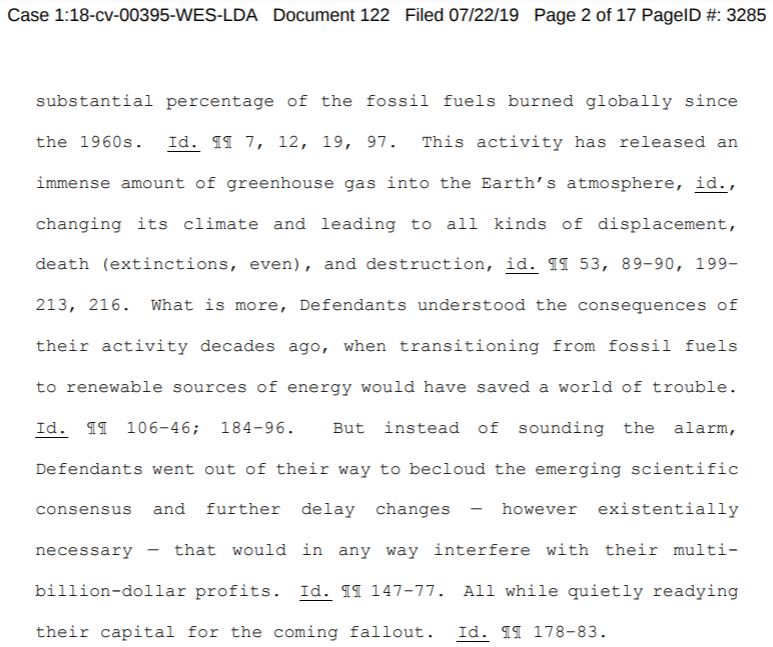
Currently publicly available here: https://ags.aer.ca/publication/spe-092.
In case AER removes the report from public access (as occurs too often after I go public with damning data/reports/papers), I uploaded it to my website.
From Page 88:
Figure 59 shows the extent of the Acheson original Blairmore T and subsequent St. Albert-Big Lake Ostracod A pools, and of the Strathfield (undefined) gas reservoir in the context of lithofacies changes in the Lower Mannville Basal Quartz and Ellerslie formations. When approval was granted for acid gas injection at Acheson, the regulatory agency required the operator to file annually with EUB and each other operator in the Acheson Blairmore T and St. Albert-Big Lake Ostracod A pools progress reports that “shall include the impact of acid gas injection on the performance of offsetting producing wells”. In March 2004 the operator at Acheson reported that CO2 was detected in 2003 in well 10-22-53-26W4 in the St. Albert-Big Lake Ostracod A pool, located at 3,625 m north from the acid-gas injection well. No H2S has been detected in the produced gas. Since at Acheson the average composition of the acid gas is 87% CO2 and 11% H2S (Table 14), with H2S being denser and more viscous than CO2, it is expected that CO2 would show first at a producing well. In addition, diagenetic processes within the reservoir could have reduced the H2S concentration in the injected acid gas as a result of pyrite precipitation, if an iron source was available. The issue was brought to EUB’s attention and was heading to a hearing, but the operator at Acheson has indicated to the regulatory agency that it has initiated an Appropriate Dispute Resolution process ![]() Anyone participating in AER’s ADR must sign a gag order as the first part of the regulator’s super secret “resolution” process
Anyone participating in AER’s ADR must sign a gag order as the first part of the regulator’s super secret “resolution” process![]() with the operator of the offset producing well to address the issue of CO2 breakthrough, and that this situation “will be addressed pursuant to the terms of the Mediated Settlement Agreement”.
with the operator of the offset producing well to address the issue of CO2 breakthrough, and that this situation “will be addressed pursuant to the terms of the Mediated Settlement Agreement”.
This case shows that, after 13 years of injection, CO2 has migrated northward a distance of [nearly 4 km] mostly under the combined drive of injection and production. The drive into the St. Albert-Big Lake Ostracod A gas pool has increased lately with the large spike in gas production from this pool (Figure 57b). There are five producing wells much closer to the acid-gas injection well (Figure 59) that did not report CO2 breakthrough, but these wells are owned by the same operator that operated until recently the Acheson acid-gas injection site. If acid gas broke through at any of these wells, it is most likely that the operator just stripped the acid gas from the sour reservoir gas and re-injected it, as the produced gas in this area is sour to begin with. Understanding the migration path and fate of the injected acid gas at Acheson requires a separate study that is beyond the scope of this report.
Below from the Abstract:
Lateral migration within the gas reservoir has been recorded in 2003 at Acheson, where, after 13 years of injection, CO2 has been detected at an offset producing well at 3,625 m distance in the same gas pool. However, migration within the same unit, particularly in a gas reservoir, is expected and its occurrence should not come as a surprise. …
….the possibility for upward leakage of acid gas exists along wells that were improperly completed and/or abandoned, or along wells whose cement and/or tubing have degraded or may degrade in the future as a result of chemical reactions with formation brine and/or acid gas. A review of the status and age of wells that penetrate the respective injection unit at each site shows that most wells were drilled in the 1950s and 1960s, and that the majority of wells are abandoned. …
